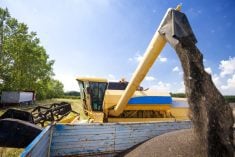Forty-eight Saskatchewan communities have already contacted the Provincial Disaster Assistance Program so they and their residents can access funding to fix flood damage.
PDAP executive director Margaret Anderson said today that more are expected to seek approval for assistance as municipalities move into the recovery stage.
Local governments and First Nations must first request an official designation as an eligible disaster area before residents can get help. They have to submit a form and pass a resolution at a council meeting.
Anderson said some of that documentation is just beginning to come in.
Read Also

Ample supplies and improved livestock sector to boost Canadian feed sector: FCC
Abundant feed grain supplies and improved profitability for the livestock sector should support strong feed demand and sales through the winter, says a new report from Farm Credit Canada.
“They have a month after the event to get their submission in to PDAP and then we will approve that and then the claims from the municipalities or individuals (can be processed),” she said.
Another rule is that the damage must be to uninsurable property. The damage experienced by one eligible claimant must exceed $5,000, or damage to multiple claimants must exceed $25,000.
Anderson noted that engineers assess the damages in municipalities while independent adjusters are used in individual cases.
Home and property owners can help by documenting what occurred: how the water got into a home, where it came in, how high it was, how long it sat, and other details. Pictures are also useful.
The toll-free number for PDAP is 866-632-4033.
Meanwhile, the number of municipalities with declared states of emergency stood at 14 today with the addition late yesterday of the Rural Municipality of Corman Park.
Colin King, deputy emergency management commissioner, said other areas could declare as localized flooding continues. The RMs of Prince Albert and Buckland are dealing with considerable water today.
He said the public should be aware the flood threat has not completely passed, even though the Water Security Agency noted that most flows are receding. Levels on the Qu’Appelle lakes will continue to rise, however.
WSA spokesperson Patrick Boyle said more than 400 people this year have now accessed the emergency flood damage reduction program. About $2.4 million has been committed so far to 92 communities, 32 RMs, 18 First Nations, 19 general applicants such as resort villages, and 245 individual yard sites.
The water is continuing to affect travellers. Highways spokesperson Kirsten Leatherdale said 21 segments of highway were under water and six of those were closed.
The closure affecting the most traffic is on the Yellowhead Highway about two kilometres east of Radisson, where both the east- and west-bound lanes were covered. Leatherdale said the water on the east-bound lanes was about 25 cm deep but only about 2.5 centimetres deep on the west side.
West-bound traffic is continuing as usual but east-bound traffic is being detoured about 80 kilometres, first north on Highway 340 to Hafford, then east on Highway 40 to Blaine Lake and finally south on Highway 12 to Saskatoon.
Leatherdale said personnel were hoping to change that this afternoon. They are bringing in an Aqua Dam, which is like a long balloon. It will be placed along the shoulder of the west-bound lanes and the water from those lanes will be pumped into it.
“As soon as we can get that water off the west-bound lanes, then we’ll move the east-bound traffic onto the west-bound lanes and we’ll run it as two-way traffic,” she said.
That process won’t work, however, on Highway 2 between Prince Albert and St. Louis, where three sections totalling about 450 metres of road are under between 60 and 67 cm of water. The detour there is on Highway 25 and Highway 3 around Birch Hills, and adds 30 to 45 minutes to the trip.

















